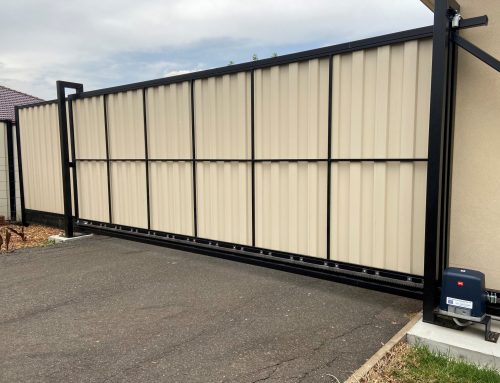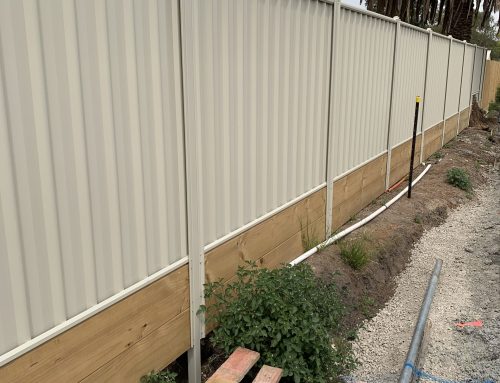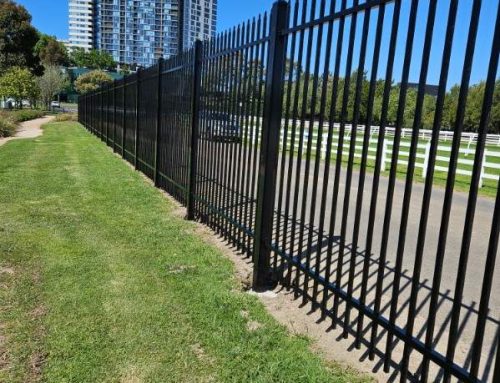Have A Questions About Cyclone Fencing? Here You Might Find The Answer!
In today’s blog we go back to basics, we go back to cyclone fencing. Diamond Fence offers a sturdy, well-known and well-trusted cyclone fencing in Melbourne, therefore we believe we can answer few questions here and there to make sure that you know about the elementary things when it comes to cyclone fencing.
Let’s start with answering a very simple question: what is cyclone fencing? It’s a simple, but yet not a silly question as some people might have no idea what cyclone fencing stands for, or just have never heard “cyclone” word before. So here you go.
CYCLONE FENCING – chain-link fencing showing the diamond patterning
In other words cyclone fencing is a chain link fencing, where the wires run vertically and bent so they will forma a zig-zag pattern and each “zig” and “zag” are hooked with the wire immediately on both sides. So there you go, you will get a diamond pattern on chain link fence, therefore you can also call it cyclone fencing. Name might be different, but the product is the same, and Diamond Fence is a cyclone fencing specialist for more than 40 years! So you know that when turning to us you’ll get one of the best chain link fencing in town – best cyclone fencing in Melbourne.
PS! Just a little side note: you can also call cyclone fencing and chain link fencing a chain wire fencing. Just so you would know…
Let’s carry on and answer the following common questions when it comes to cyclone fencing:
1. How strong is cyclone fencing and how long does cyclone fencing last?
2. How does cyclone fencing fights the corrosion?
3. Can I get any size cyclone fencing to match my desired measurement?
4. How complicated is installation of the cyclone fencing and can I do it on my own?
5. What are the most common applications for cyclone fencing?
First things first. How strong is cyclone fencing? We’d say pretty strong. It’s not the strongest fencing material out there, for example if you compare it to tubular steel fencing, but it’s strong. But is it strong enough? Well, it depends of the reason you are planning to install it in the first place. If it’s just for your personal back yard or just to surround your playground, then yes, it it strong enough. When it comes to highly valuable industrial warehouses and you have to make sure that your fence will not let anyone through, then in that case we would suggest to turn to steel fencing like tubular steel, welded mesh or even Colorbond steel fencing as they are much harder to break through.
When it comes to determining how strong is your cyclone fence, then remember: the smaller the gauge number, the stronger is your cyclone fence and therefore the longer is its lifespan, not significantly, but still considerably, if that makes sense.
How long does cyclone fencing last? Usually it lasts for 15 to 20 years. If you compare to the wooden fence that lasts also around 15 years, then remember that maintenance and replacement of the cyclone fence is much easier and cheaper.
When it comes to corrosion, then chain link fencing is either galvanized or PVC coated. These coatings will help to fight the corrosion and also will make it look nicer and help it to blend in with the environment. PVC coating for the chain link fencing is also a good way to protect the ball from getting scratched on your sporting grounds. For example on a cricket ground, or a baseball diamond.
Hmm…measurements…yes…With Diamond Fence you can get any size and shape of cyclone fencing that you need for your back yard, or for any industrial purposes. But do remember that when it comes to PVC coating, then Diamond Fence offers only black and green plastic coated chain wire. But these are the colours that blend with the environment the best!
Okay, let’s see how complicated is it to install a cyclone fence and should you do it by yourself? Installation of a cyclone fence, or chain link fence, involves simply said setting the posts into the ground and then attaching the fence to them. The complexity of it depends what kind of posts do you want to install. Will they be steel, timber or concrete posts instead. Regardless which one you choose, the terminal posts (corner or gate posts) have to be extra secured (concrete footing) so they will prevent the whole fence from leaning one way or another when it comes to stretching the fence under the tension.
You attach the cyclone fence one one side/post and then you will stretch it, then attach it to another post next to it, and so on. In many cases you will stretch a bottom tension wire between the terminal posts to minimize the in and out movements at the bottom of the chain link mesh between the posts. And also horizontal rails are used for cyclone fences, but are not mandatory. And a tension wire in the centre is also installed before applying the chain link mesh to the fence.
As you see there’s a lot to do and it’s not an easy job, especially when it comes to a longer fence installation. Installing the fence posts, tension wires, chain link mesh itself, it’s a hard work, especially when you don’t have the proper equipment. So if you are wise, you will let the proper fence installer to do the job. Someone like us, Diamond Fence. At least then you will have the assurance that your fence was installed correctly. Believe us, it’s worth the money. It will save you time and you’ll also know that you will have to spend time on arranging it once in 15-20 years (with some minor repairs in between) and not keep on fixing it every few years as the posts you installed by yourself without proper equipment keep on moving and the cyclone fence with it.
And to answer our fifth and last question, we will name some of the applications you can use cyclone fencing for. Here they are:
- Building Sites
- Boundary Fencing
- Security Fencing
- Warehouse Partitions
- Storage Enclosure Fencing
- Access Gates
- Government Departments
- Window Guards
- Pallet Racking Safety Fences
Here you go! Hopefully we’ve answered few of your questions. If not then just contact us, Diamond Fence, and we are more than happy to answer fencing related questions in Melbourne.
Call us on (03) 9753 4566, shoot us an email on info@diamondfence.com.au, or just get a FREE online quote.








